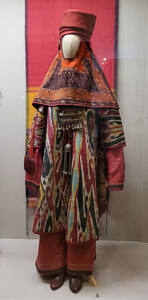Silk in the Culture of Central Asia and Eastern Turkestan

In the Horezm Oasis, the oldest civilization center in Central Asia, silk weaving on imported raw materials though existed has not been much developed. However, the population of the oasis would always include items of the purchased silk as part of the festive attire. Modal fiber was especially valued; it presented long streaks of red silk, weaved as piece goods. At the same time, each people of the oasis had their own silk tradition: the Uzbeks of Northern Horezm used it for their turbans, men everywhere used it for their belts, and the young Karakalpaks draped it over their heads as a wrapper. According to some sources, the modal fibers were made by Turkmen tribes that inhabited the oases of ancient agricultural area in the Amudaria basin, historically associated with Horezm.
1. Spinning wheel. Russian Turkestan. 1860s. Uzbeks
2. Young woman’s attire. Amu Darya River delta. Late 19th – early 20th century. Karakalpaks
3. Women’s headscarf, element of the festive headwear. Horezm Oasis. 1910s. Uzbeks



